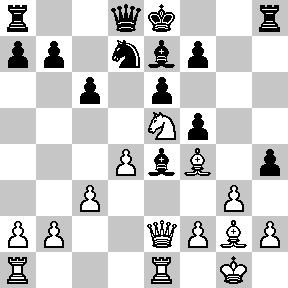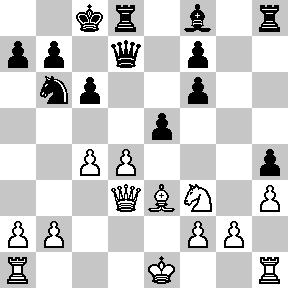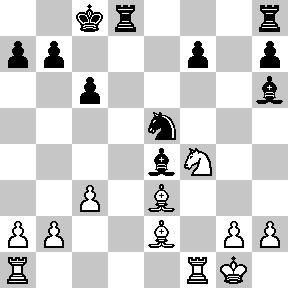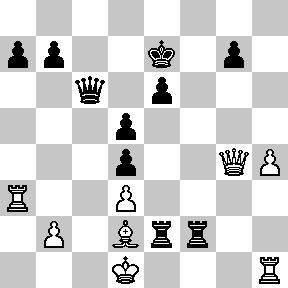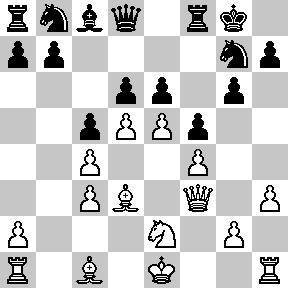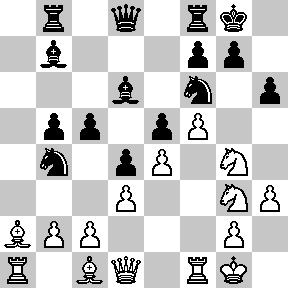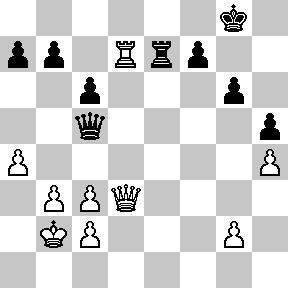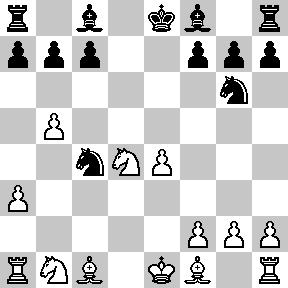Good Work by Gata
 The one time prodigy, American GM Gata Kamsky was having the devil of a time playing with the sharks at Wijk aan Zee 2006 before scoring a startling breakthrough today. Armed with the white pieces, he leveled tournament leader Viswanathan Anand to climb out of the basement in the standings. First though, let's recap his experience in the event thus far.
The one time prodigy, American GM Gata Kamsky was having the devil of a time playing with the sharks at Wijk aan Zee 2006 before scoring a startling breakthrough today. Armed with the white pieces, he leveled tournament leader Viswanathan Anand to climb out of the basement in the standings. First though, let's recap his experience in the event thus far.Round one started out as follows:
Topalov,V (2801) - Kamsky,G (2686)
Corus A Wijk aan Zee NED (1), 14.01.2006
1.e4 d5 2.exd5 Nf6 3.Nf3 Nxd5 4.d4 Bf5 5.Bd3 Bxd3 6.Qxd3 e6 7.0-0 Nc6 8.c4 Nb6 9.Nc3 Be7 10.Bf4 g5 11.Bg3 g4 12.Ne5 Nxd4 13.c5 Bxc5 14.Rad1 0-0 15.Ne4 Be7 16.Nxg4 c5?
 Kamsky knew he should play solidly against the reigning FIDE Champion, so he opted for the Scandinavian defense, but he soon allowed himself to be tempted into grabbing pawns, capturing first one and then a second on moves 12 and 13. The position quickly became critical, and Kamsky's 16. ... c5? infact loses by force, as cleverly noted by Kasparov, who was watching the game live on the internet. Instead of Topalov's 17. b4, white should have played 17.Be5! (threatening 18.Nh6#) f6 18. Ng5!! (threatening 19. Qxh7# and, if 18. ...fxg5 then 19. Nh6#) 18...Nf5 19. Nh6 and black is finished. The game did not last long anyway though, concluding with Kamsky's resignation at move 26.
Kamsky knew he should play solidly against the reigning FIDE Champion, so he opted for the Scandinavian defense, but he soon allowed himself to be tempted into grabbing pawns, capturing first one and then a second on moves 12 and 13. The position quickly became critical, and Kamsky's 16. ... c5? infact loses by force, as cleverly noted by Kasparov, who was watching the game live on the internet. Instead of Topalov's 17. b4, white should have played 17.Be5! (threatening 18.Nh6#) f6 18. Ng5!! (threatening 19. Qxh7# and, if 18. ...fxg5 then 19. Nh6#) 18...Nf5 19. Nh6 and black is finished. The game did not last long anyway though, concluding with Kamsky's resignation at move 26.Gata recovered for an interesting game in round 2 against Israeli GM Boris Gelfand, but the final result was a product of Boris' blunder in a theoretically drawn position in the end.
Kamsky,G (2686) - Gelfand,B (2723)
Corus A Wijk aan Zee NED (2), 15.01.2006
1.d4 d5 2.c4 c6 3.Nc3 Nf6 4.Nf3 dxc4 5.a4 Bf5 6.Ne5 Nbd7 7.Nxc4 Qc7 8.g3 e5 9.dxe5 Nxe5 10.Bf4 Nfd7 11.Qc1 g6 12.Bg2 Bg7 13.0-0 0-0 14.a5 Be6 15.Nxe5 Nxe5 16.a6 bxa6 17.Rxa6 Rab8 18.Qa1 Qb7 19.Ra5 Nc4 20.Rxa7 Qxb2 21.Bxb8 Qxb8 22.Rb1 Qe5 23.Rc1 Nd2 24.Rc2 Nb3 25.Qa3 Qb8 26.Bxc6 Bxc3 27.Rxc3 Nd4 28.Ra8 Nxe2+ 29.Kg2 Qxa8 30.Bxa8 Nxc3 31.Qa5 Nb5 32.f3 Nd6 33.g4 Rc8 34.Kg3 Nc4 35.Qa1 Rd8 36.h4 Ne3 37.Be4 Nd5 38.Qe5 h6 39.Bxg6 Rd7 40.Be4 Ne7 41.Qf6 1-0
The critical position came at move 31:
 Here Gelfand had to play 31. ... h5 in order to stem white's attacking chances against his kingside pawns on the white squares and to give his monarch some room to breathe. The option was again available on move 32, but Gelfand never saw it.
Here Gelfand had to play 31. ... h5 in order to stem white's attacking chances against his kingside pawns on the white squares and to give his monarch some room to breathe. The option was again available on move 32, but Gelfand never saw it.The torture resumed in round 3, as the youthful GM Sergey Karjakin steamrolled Kamsky's Kan Sicilian with a grinding Maroczy Bind.
Karjakin,Sergey (2660) - Kamsky,G (2686)
Corus A Wijk aan Zee NED (3), 16.01.2006
1.e4 c5 2.Nf3 e6 3.d4 cxd4 4.Nxd4 a6 5.Bd3 Nf6 6.0-0 d6 7.c4 g6 8.Nc3 Bg7 9.Be3 0-0 10.Rc1 Nbd7 11.Qd2 Qc7 12.f3 b6 13.Rfd1 Bb7 14.Bf1 Rfc8 15.b4 Bf8 16.a3 Rab8 17.Kh1 Qd8 18.Qf2 Ne5 19.Na4 Nfd7 20.Nb3 Ba8 21.Nb2 Rc7 22.Na4 Rcc8 23.Bd4 Rc6 24.c5 bxc5 25.Naxc5 Nxc5 26.Nxc5 Qc8 27.Qe3 Bb7 28.Bxe5 dxe5 29.Nd7 Rxc1 30.Qxc1 Ra8 31.Nb6 Qxc1 32.Rxc1 Rd8 1-0
Karjakin's 29. Nd7! was just brutal, but this game was white's all the way.

In round 4, paired against GM Levon Aronian - fresh from winning the FIDE Knockout Tournament - Kamsky again over pressed iwth the white pieces and found himself in a miserable, albeit somewhat drawable game. The game needs very little explanation - the American GM simply lost a pawn in the opening and then struggled violently to try to eke out the draw.
Kamsky,G (2686) - Aronian,L (2752)
Corus A Wijk aan Zee NED (4), 17.01.2006
1.e4 e5 2.Nf3 Nc6 3.Bb5 a6 4.Ba4 Nf6 5.0-0 Be7 6.Bxc6 dxc6 7.d3 Bd6 8.Nbd2 Be6 9.b3 Nd7 10.Bb2 c5 11.g3 0-0 12.Nh4 Re8 13.Nf5 Bxf5 14.exf5 Qg5 15.f6 Nxf6 16.Ne4 Qf5 17.Nxf6+ Qxf6 18.f4 Qh6 19.f5 e4 20.Re1 Rad8 21.Qg4 exd3 22.cxd3 Bf8 23.Rxe8 Rxe8 24.Rd1 Qe3+ 25.Kf1 g6 26.Bc1 Qe5 27.fxg6 hxg6 28.Qf3 Qa1 29.Qf2 Bg7 30.Kg2 Qe5 31.Rf1 Qe7 32.Bg5 Qd7 33.Qf3 Bd4 34.g4 c6 35.h4 Re6 36.Kh3 b5 37.Bd2 Rf6 38.Qg2 Rd6 39.Bf4 Rd5 40.Rf3 Qe6 41.Bg3 Bg7 42.Qf1 Rd8 43.Bf2 Qd5 44.Qe2 Bf8 45.Kg2 Rd6 46.Kg1 Re6 47.Re3 Rxe3 48.Bxe3 Qe5 49.Kf1 Qg3 50.h5 Qh3+ 51.Kg1 Bd6 52.hxg6 fxg6 53.Bf4 Bf8 54.Qe6+ Kh7 55.Qd7+ Bg7 56.Kf2 Qh4+ 57.Ke2 Qf6 58.Ke3 Qa1 59.g5 Qe1+ 60.Kf3 Qf1+ 61.Ke3 c4 62.dxc4 bxc4 63.bxc4 Qc1+ 64.Kf3 Qxc4 65.Qh3+ Kg8 66.Qc8+ Bf8 67.Qe8 Qd3+ 68.Be3 c5 69.Qc6 Qf1+ 70.Kg3 Qe1+ 71.Kf4 Qh4+ 72.Ke5 Qh8+ 0-1
Kamsky succumbed to the dreaded bind again in round 5, this time with Ivanchuk demonstrating his superior technique in a grueling positional struggle.
Ivanchuk,V (2729) - Kamsky,G (2686)
Corus A Wijk aan Zee NED (5), 19.01.2006
1.e4 c5 2.Nf3 e6 3.d4 cxd4 4.Nxd4 a6 5.Bd3 Bc5 6.Nb3 Ba7 7.Qe2 d6 8.Be3 Nf6 9.Bxa7 Rxa7 10.c4 Nc6 11.Nc3 0-0 12.0-0 b6 13.Qe3 Qc7 14.Be2 Qb8 15.Rfd1 Rd8 16.Rd2 e5 17.Rc1 Be6 18.Rcd1 h6 19.h3 Rb7 20.Bf1 b5 21.cxb5 axb5 22.Nd5 Bxd5 23.exd5 Ne7 24.Na5 Rc7 25.Nc6 Nxc6 26.dxc6 Rxc6 27.Qxe5 b4 28.Qd4 Qb6 29.Bc4 Qxd4 30.Rxd4 Rb6 31.Bb3 Kf8 32.g4 Ke7 33.Re1+ Kf8 34.Rc1 Rd7 35.Rc8+ Ke7 36.h4 g5 37.Rh8 Rd8 38.Rxh6 Rg8 39.f3 gxh4 40.Rxh4 d5 41.Kf2 Rbb8 42.Ke3 Kd6 43.Rh6 Rbe8+ 44.Kf4 Kc5 45.Rd2 Rg6 46.Rh1 Reg8 47.Rc1+ Kd6 48.Rdc2 Rd8 49.Rc7 Rd7 50.R1c6+ Ke7 51.Bc2 d4 52.Rxd7+ Kxd7 53.Bxg6 Kxc6 54.Bxf7 1-0
After the game Kasparov finally dismissed the American as a legitimate contender, remarking: "Kamsky is from a different era and it shows." It'll be interesting to see what he says after today's powerhouse showing.
Kamsky,G (2686) - Anand,V (2792)
Corus A Wijk aan Zee NED (5), 20.01.2006
1.d4 d5 2.c4 dxc4 3.e4 Nf6 4.e5 Nd5 5.Bxc4 Nb6 6.Bd3 Nc6 7.Ne2 Be6 8.Nbc3 Qd7 9.Ne4 Bd5 10.Be3 O-O-O 11.a3 Qe8 12.Qc2 f5 13.N4c3 Bxg2 14.Rg1 Bf3 15.Bxf5+ e6 16.Bh3
 In a dramatic departure from his earlier play, Kamsky came out with both fists in this game, declaring his belligerence right away in the opening! 16. ... Kb8 17.Rg3 Bxe2 18.Nxe2 Nd5 19.Nc3 Nxe3 20.fxe3 Qh5 21.Qe2 Qxe2+ 22.Kxe2 Re8 23.Rf1 Nd8
In a dramatic departure from his earlier play, Kamsky came out with both fists in this game, declaring his belligerence right away in the opening! 16. ... Kb8 17.Rg3 Bxe2 18.Nxe2 Nd5 19.Nc3 Nxe3 20.fxe3 Qh5 21.Qe2 Qxe2+ 22.Kxe2 Re8 23.Rf1 Nd8 Anand has managed to force most of the aggressive pieces off the board, but Kamsky's structure is much stronger and black is clearly scrambling for drawing chances. Look out how all of Anand's piece have found their way to the back rank!
Anand has managed to force most of the aggressive pieces off the board, but Kamsky's structure is much stronger and black is clearly scrambling for drawing chances. Look out how all of Anand's piece have found their way to the back rank!24.Ne4 g6 25.Ng5 Re7 26.Rgf3 Bh6 27.Nf7 Nxf7 28.Rxf7 Rhe8 29.R1f6 a5 30.Rxe7 Rxe7 31.Rxe6 Rxe6 32.Bxe6 Bg5 33.d5 Ka7 34.Bg8 h6 35.Bf7 Kb6 36.Bxg6 Kc5 37.Bf7 h5 38.Kd3 h4 39.h3 b5 40.Ke4 b4 41.axb4+ axb4 42.b3 Bh6 43.Bh5 Bg5 44.Be2 Bh6 45.Bc4 Bg5 46.Kf5 Bxe3 47.d6 1-0 Wonderful technique by Gata Kamsky, proving that it's a little early to declare him over the hill!
